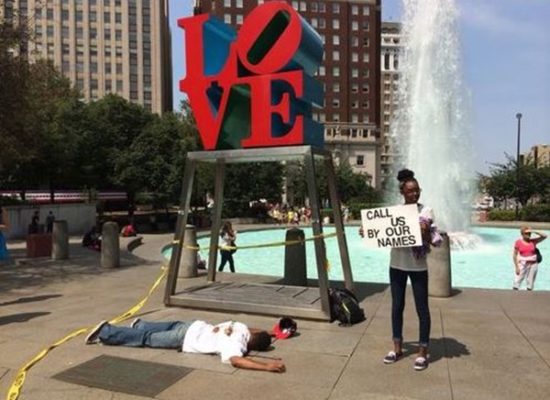Opinion
Robert Indiana Fans Ignore Artist’s Ferguson Protest
Keith Wallace's action in Philly dramatized today's racial divide all too well.
Keith Wallace's action in Philly dramatized today's racial divide all too well.
Ben Davis


The killing of black teenager Michael Brown by a white police officer has touched off more than a week of unrest in Ferguson, Missouri, and protests across the country. Coming in the wake of the nationwide protests around the killing of Trayvon Martin in Florida and the recent shocking death of Eric Garner in New York, the incident has also thrown a stark light on what Michelle Alexander calls the “New Jim Crow,” the sharp divide in the way that African-Americans and whites experience, and even perceive, the law in today’s United States.
On Saturday, this divide received striking illustration in an unexpected place: Robert Indiana’s LOVE sculpture in Philadelphia. For more than an hour, Keith Wallace, a young actor, lay as if dead in a shirt bloodied by fake bullet holes in front of the iconic artwork, which was draped in a garland of police “CAUTION” tape. Two friends looked on holding a sign that read “Call Us By Our Names”—a reference, Wallace said in a statement distributed to observers, to how the media and authorities distort the reality of police violence against people of color: “Pay attention as ‘teen’ becomes ‘man,’ ‘community’ becomes ‘mob,’ and ‘murder’ becomes ‘alleged shooting.’ CALL US BY OUR NAMES!!!”
The two-sided statement (viewable on Scribd) featured information on one side from the American Civil Liberties Union about rights if stopped by the police. On the other, a lengthy text explained that Wallace was an artist “[t]rying in my small way to make an impact on what I perceive as the Civil Rights Movement of my generation.” It called for citizens to know their rights, for transparency and accountability on the part of law enforcement, and for police to wear cameras to document misconduct. Its most vivid passage, however, had Wallace speaking personally about the realities of race in the United States:
I am racially charged. Not because I want to be but because I HAVE to be. I am racially charged because in certain instances that hyper awareness might ensure that I make it home to my family alive at the end of the day. I am racially charged because I am not afforded the luxury to wander through life with my head in the (nonexistent) “post racial America” clouds. I “SEE color” because MY COLOR IS SEEN and dismissed and devalued and implicated as a threat everywhere I go. I am racially charged. And if my speaking about it, my calling attention to it makes you uncomfortable, then I implore you to do something to eradicate the ugliness I see every day in the world.
As to why Wallace chose LOVE as the site for his action, he told ThinkProgress’s Jessica Goldstein that, “for me, there’s some potency in juxtaposing those kinds of images together: love and death.” Some observers were visibly moved by the gesture. Speaking to Philadelphia Magazine, Wallace recalled one such reaction:
There was a Latina woman with two young boys. She held her boys’ hands and said to them, ‘I want you to see this. This is important. Never be afraid to tell the truth.’
Others, however, were too eager to snap a picture with LOVE to be bothered with Wallace’s statement, willfully ignoring the protest—and unintentionally reinforcing its message about how the reality of police brutality is often ignored by society. Wallace explained to ThinkProgress:
One of the most hurtful things [was when] a group of friends wanted to take a picture, and one guy said, ‘I don’t want to be a part of this,’ and their friend said ‘What’s the big deal? He’s already dead.’ The people who were assisting me said one girl stepped over the body to get closer to the statue to take a picture, and the wind blew at that moment and wrapped the caution tape around her foot. [She had] no reverence for, no acknowledgement of, what’s right in front of her.